*FYI - this post may contain affiliate links, which means we earn a commission at no extra cost to you if you purchase from them. Also, as an Amazon Associate I earn from qualifying purchases. Check out our Privacy Policy and Disclosure. for more info.
Plucked from the pages of a storybook, Colmar is a fairytale town in Alsace that is almost unfairly pretty, with half-timbered houses in glorious pastel shades, flower boxes overflowing with fresh blooms, winding canals to stroll along, and some of the nicest Christmas markets in Europe.
Having been there three times now, I can’t deny that Colmar is one of the prettiest places I’ve ever been.
To be totally honest though, there is a catch… and for some it might be a big one: there’s actually not that many things to do in Colmar. Unless you count gaping at nice views… in which case, fret not – there’s plenty of that.
So, if you need help planning what to do in Colmar, this post will share a thorough list of potential activities including museums, markets and… giant statues? Yes. There are indeed some surprises here. Read on for more!
1. Explore La Petite Venise
The enchanting district of La Petite Venise (Little Venice) is what most visitors flock to Colmar for. So naturally, that’s the #1 thing to do in when exploring the city.
Once upon a time, this area would have been a center for fishmongers and tanners, utilizing the Lauch River for their trades. Over the centuries, La Petite Venise has retained its medieval charm, with narrow streets and quaint bridges that invite visitors to step back in time.
Today, this part of the city is filled with postcard-perfect canals flanked by vibrant half-timbered houses… all a glorious photogenic dream that’s best discovered on foot. Colmar is compact, so it’s tough to get lost.
I say head down whichever streets look interesting to you and explore that way – things are a lot more fun when you get to break away from the standard tourist route (though doing so might prove impossible during peak season).

And for a different perspective of the city, you can also book a boat tour like this one.
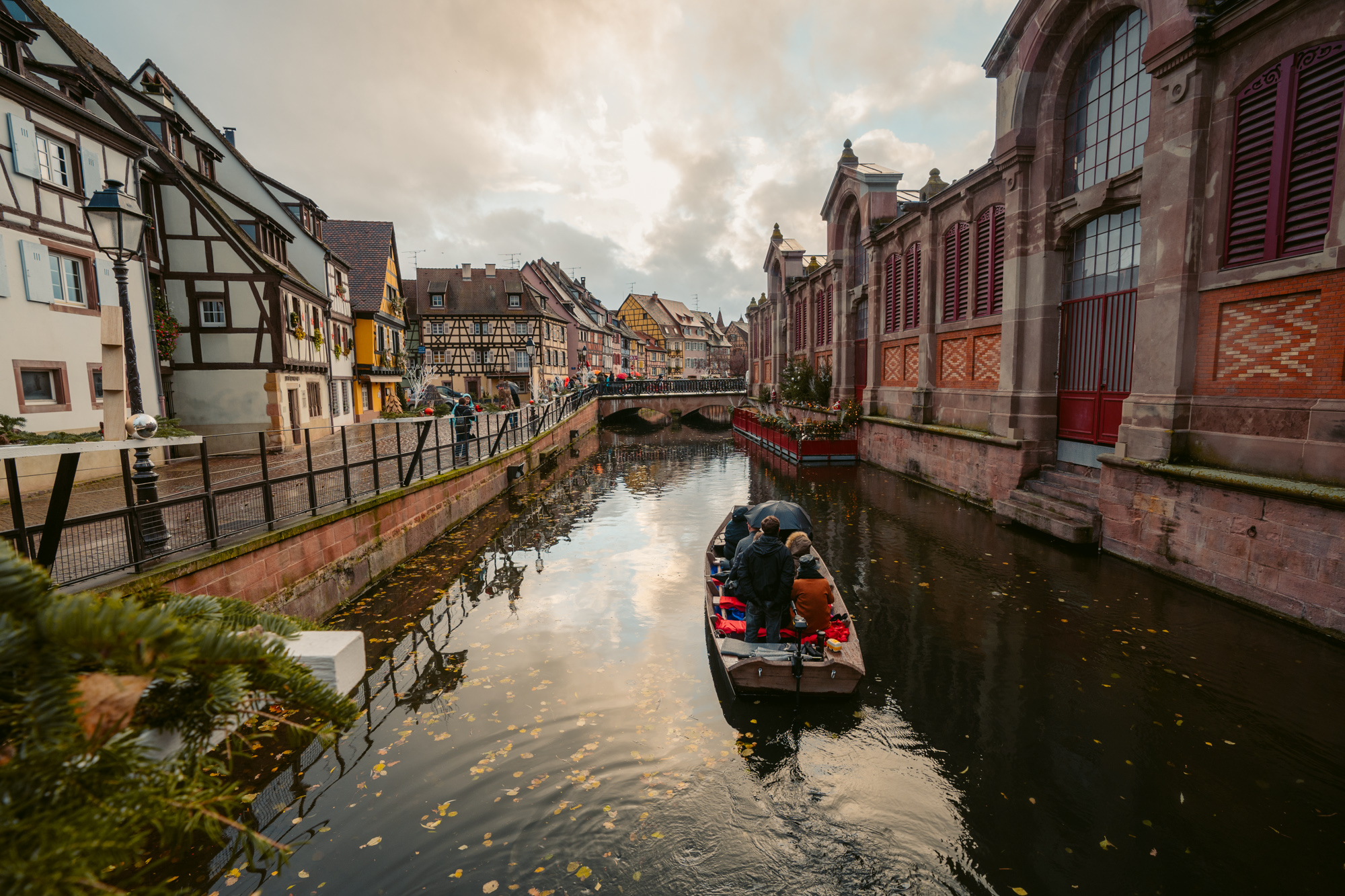
2. See the Old Customs House (Koïfhus)
In and around Petite Venise, there are a number of special sights to take in. One main one is the Old Customs House, a medieval gem in Colmar that was once the center of trade in the city.
Constructed in 1480, the Koïfhus was strategically located at the intersection of major trade routes, functioning as a customs house where goods were taxed and traded. Its ground floor was used for storing merchandise and as a marketplace, while its upper floors housed administrative offices and meeting rooms for the town council, as well as the Décapole, an alliance of ten imperial cities in the Alsace region.
Architecturally, the Old Customs House is a striking example of late Gothic design with Renaissance influences. The building features a fortress-like structure with a steep, tiled roof and intricately carved stone decorations. Other notable elements include the ornate corner tower and the elegant arcades that open onto the bustling Place de l’Ancienne Douane.
During my first visit to Colmar, there was a wine festival held in/around this house, which made me fall for it instantly. In the winter, it’s also home to a handicraft Christmas market, so needless to say there’s always something going on here.
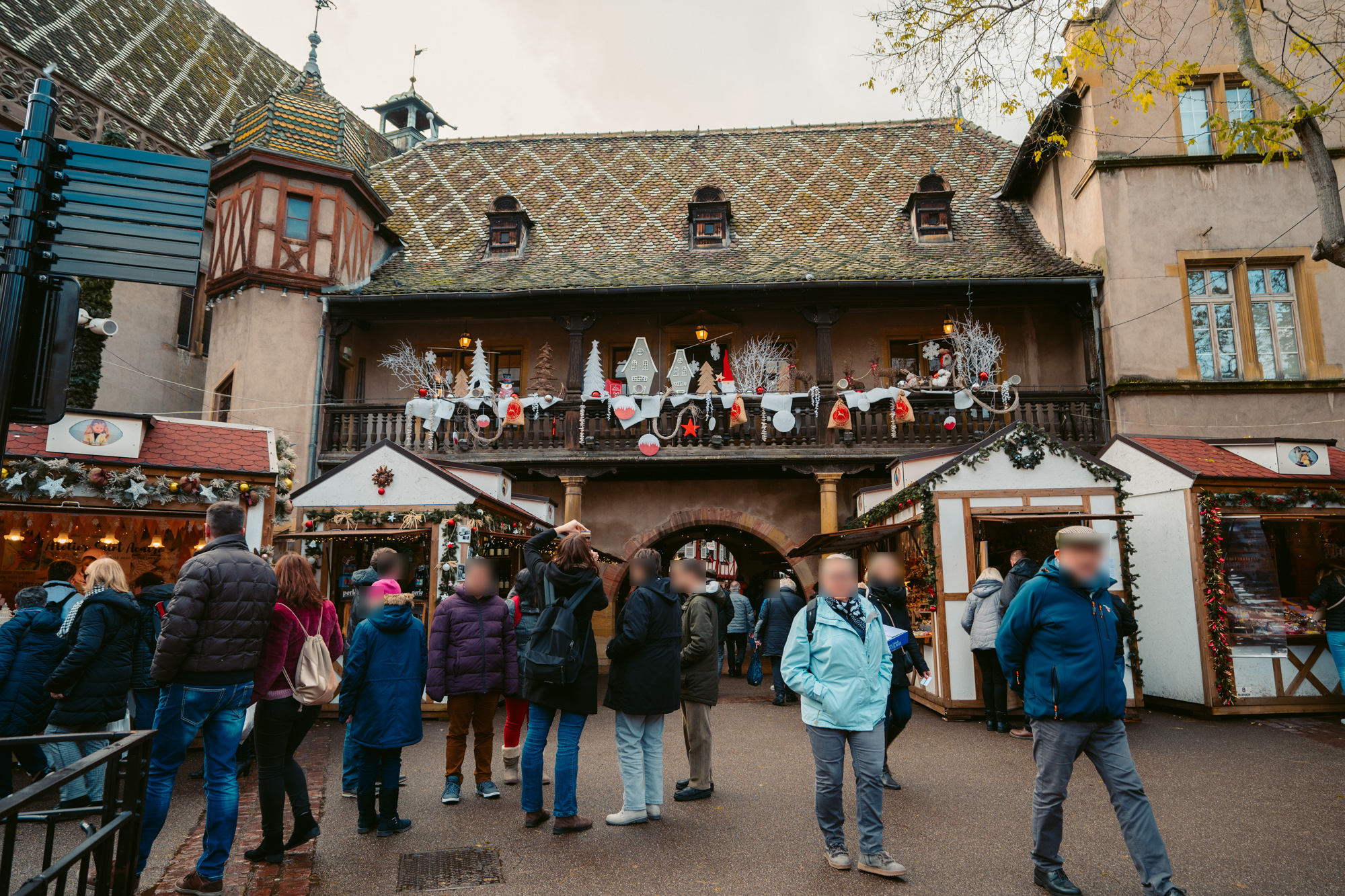
3. The Pfister House
Another must-see in this area is the Pfister House (or Maison Pfister), a beautifully preserved Renaissance building known for its ornate façade.
Built in 1537 for the wealthy hatter Ludwig Scherer, its most striking features include the beautifully painted wooden gallery, a corner oriel window, and a turreted octagonal staircase tower. To keep up its overachiever status, the façade is also adorned with intricate frescoes depicting biblical scenes, allegorical figures, and coats of arms.
Now, besides looking cool, what’s so special about this house? Well, the Pfister House is historically significant as it marks a transition in architectural styles which symbolize the prosperity and aesthetic sensibilities of 16th-century Colmar. Named after a later owner, François Joseph Pfister, who lived there in the 19th century, the house has become an iconic landmark in Colmar’s old town.
You can’t go inside (aside from a wine shop on the ground floor) but it’s well worth popping by to marvel at its whimsical design. You can find it at 11 Rue des Marchands.
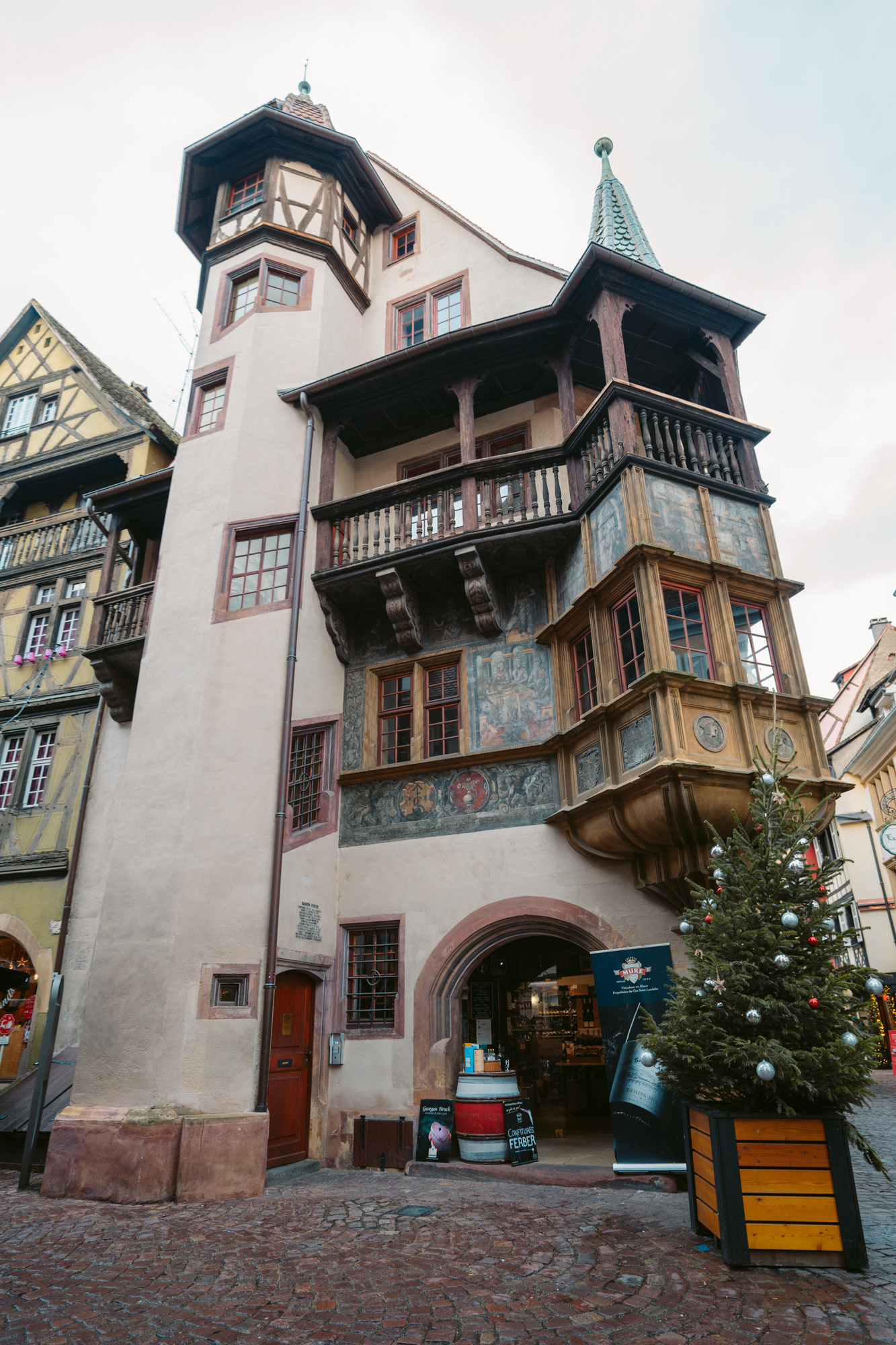
4. Enjoy a wine tasting
Of course, besides ogling the sights, one of the most relaxing things to do in Colmar is enjoying a taste of local Alsatian wine.
There are plenty of options for this in the city. This walking tour, for instance, includes one.
You can also look into wine cellars like…
- Domaine Karcher: The tasting cellar of a local winery that makes organic wines. You can find the cellar in a yellow building at 11 Rue de l’Ours.
- Le Cercle Des Aromes: This wine bar offers tastings by the glass of wines from all over France, including local ones from the Alsace region, with tasty charcuterie-type dishes to accompany your wine.
- Wolfberger Boutique: On the outskirts of Colmar is the tasting room for Wolfberger, which provides free tastings of its huge selection of wines and brandies.
5. Colmar Covered Market (Marché Couvert)
For a look at tasty local products beyond wine, the Colmar Covered Market is a great spot – with regional cheeses, food products and fresh produce in abundance.
This market was designed by architect Louis-Michel Boltz in a striking mix of cast iron, brick, and glass, reflecting the industrial advancements of the 19th century. Constructed in 1865, the market features large windows and airy, open spaces, which allows natural light to flood the interior.
If you’re looking to get the makings of a picnic the market is perfect, plus it has a number of restaurants located within if you want to sit down to eat, including a beautiful terrace overlooking the river. NOTE: It does close fairly early, especially on Sundays, so be sure to check hours before you go!
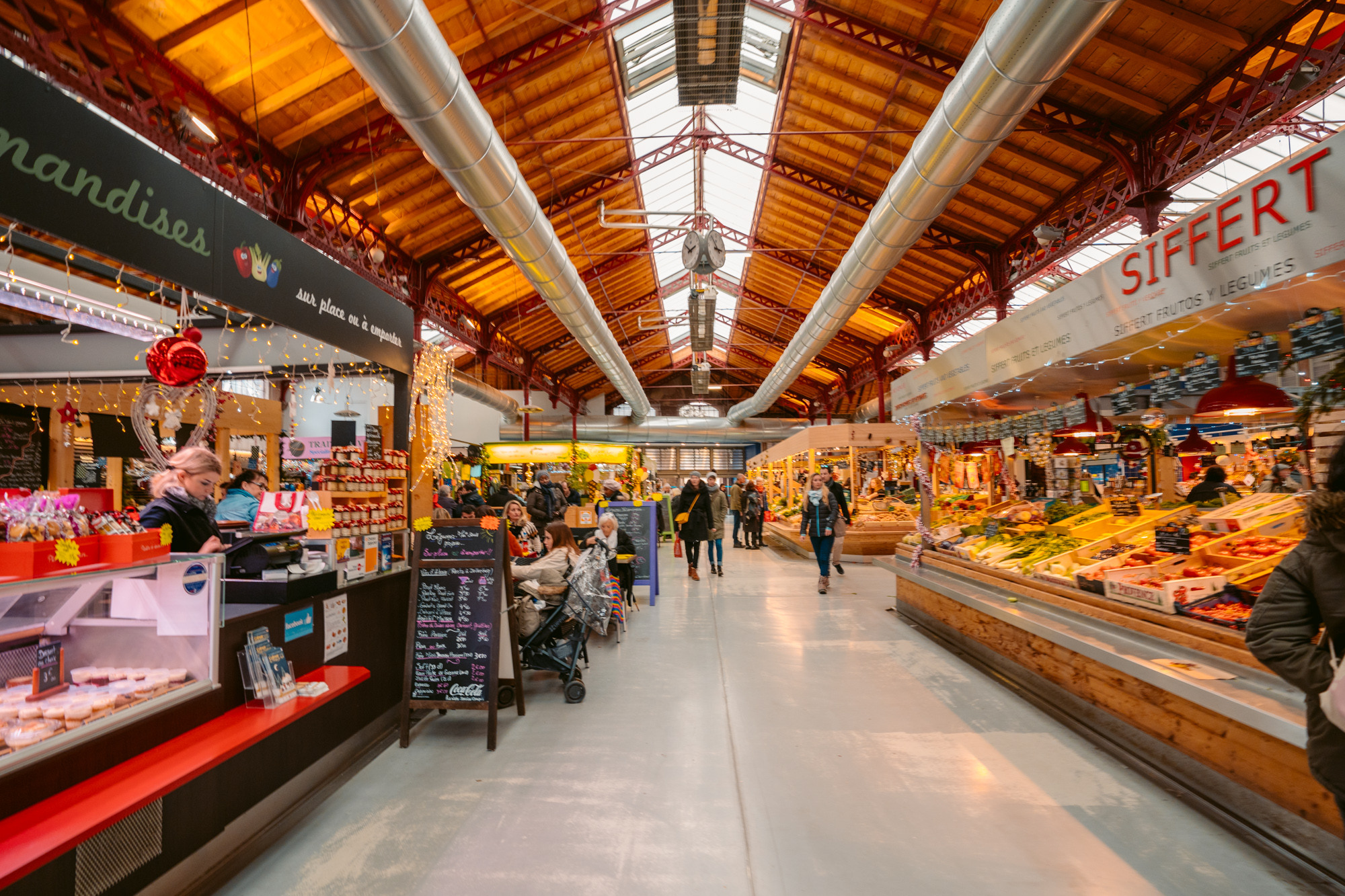
6. Collegiate Church of Saint Martin
Another nice spot to visit in Colmar is the beautiful Gothic Collegiate Church of Saint Martin.
Construction of the church began in 1234 and continued over several centuries, with major works completed by the mid-14th century. Its grand design features soaring spires and stone carvings, along with beautiful stained glass windows. Inside, the church boasts more remarkable works of art, including an ornate choir, medieval frescoes, and a notable organ.
If you’re into exploring more churches, there are few other nice options in Colmar, including…
- Dominican Church: known for its beautiful stained glass windows
- St. Matthew’s Church: known for its intricate woodwork and impressive organ
- Church of St. Joseph: known for its red stone exterior and impressive bell tower
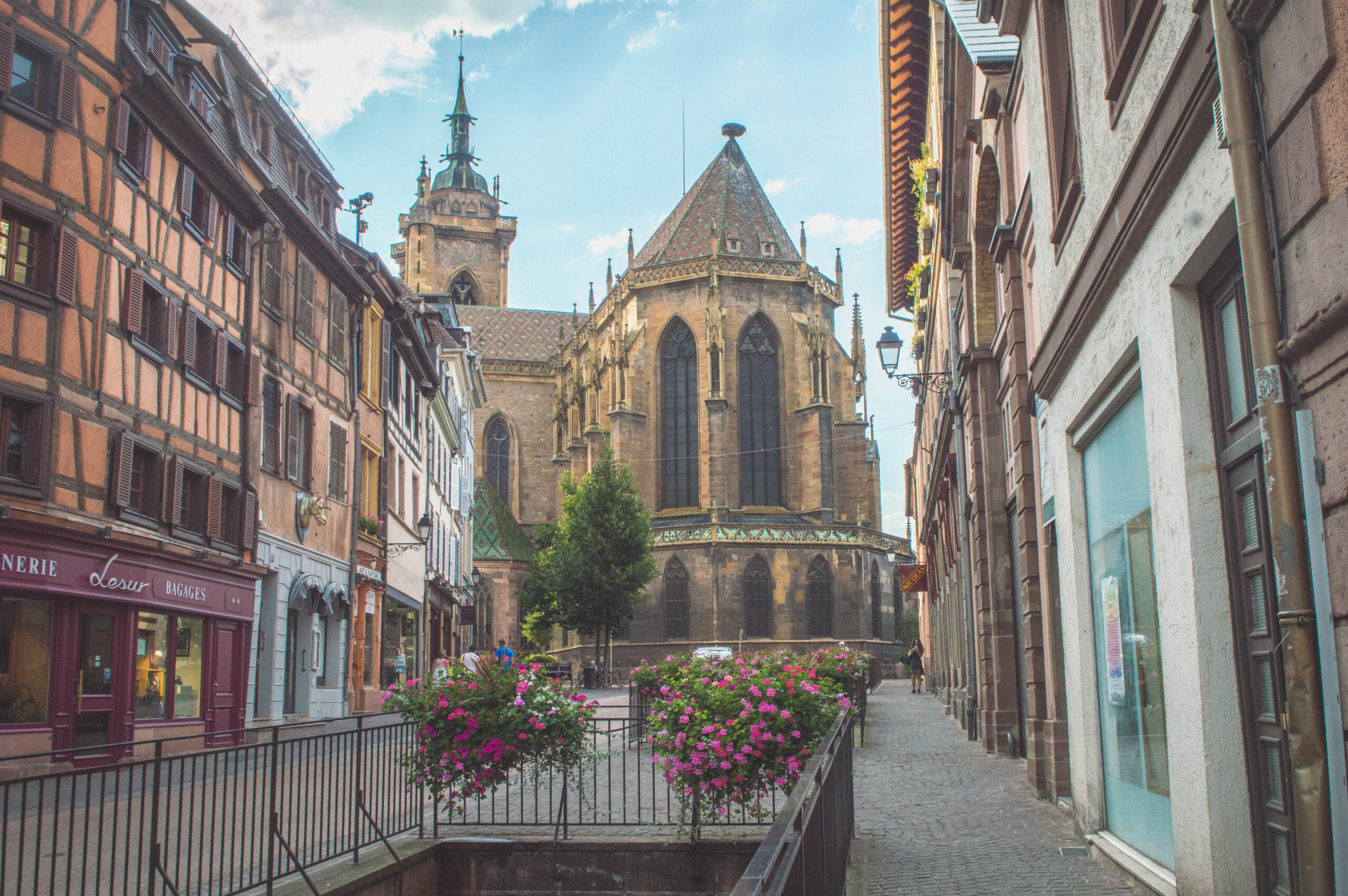
7. House of Heads (Maison des Têtes)
One of the weirder things to do in Colmar is a visit to the Maison des Têtes, AKA the House of Heads… a Renaissance building adorned with over a HUNDRED sculpted heads.
A reasonable follow-up question here might be “why?”
Well, we don’t really know, but we do know that the building was constructed in 1609 for the wealthy merchant Anton Burger by architect Albert Schmidt. Anton Burger later became Colmar’s mayor but was forced to flee during the Catholic reform. Along with all the heads, the building’s ornate façade also features beautiful bay windows, decorative gables, and finely detailed stonework.
Today, La Maison des Têtes is more than just an architectural marvel; it has been transformed into a luxury hotel and gourmet restaurant. If you can afford to eat or stay there it would be pretty cool, but otherwise, make sure you just stop by to see the weird heads!
8. Cozy into a nice cafe
Now, once you’ve completed the regular sightseeing circuit around Colmar, I can highly recommend taking a breather in one of the city’s many beautiful cafes. I thought the hot chocolate at Au Croissant Doré was outstanding (as was its adorable pink, croissant-themed facade).
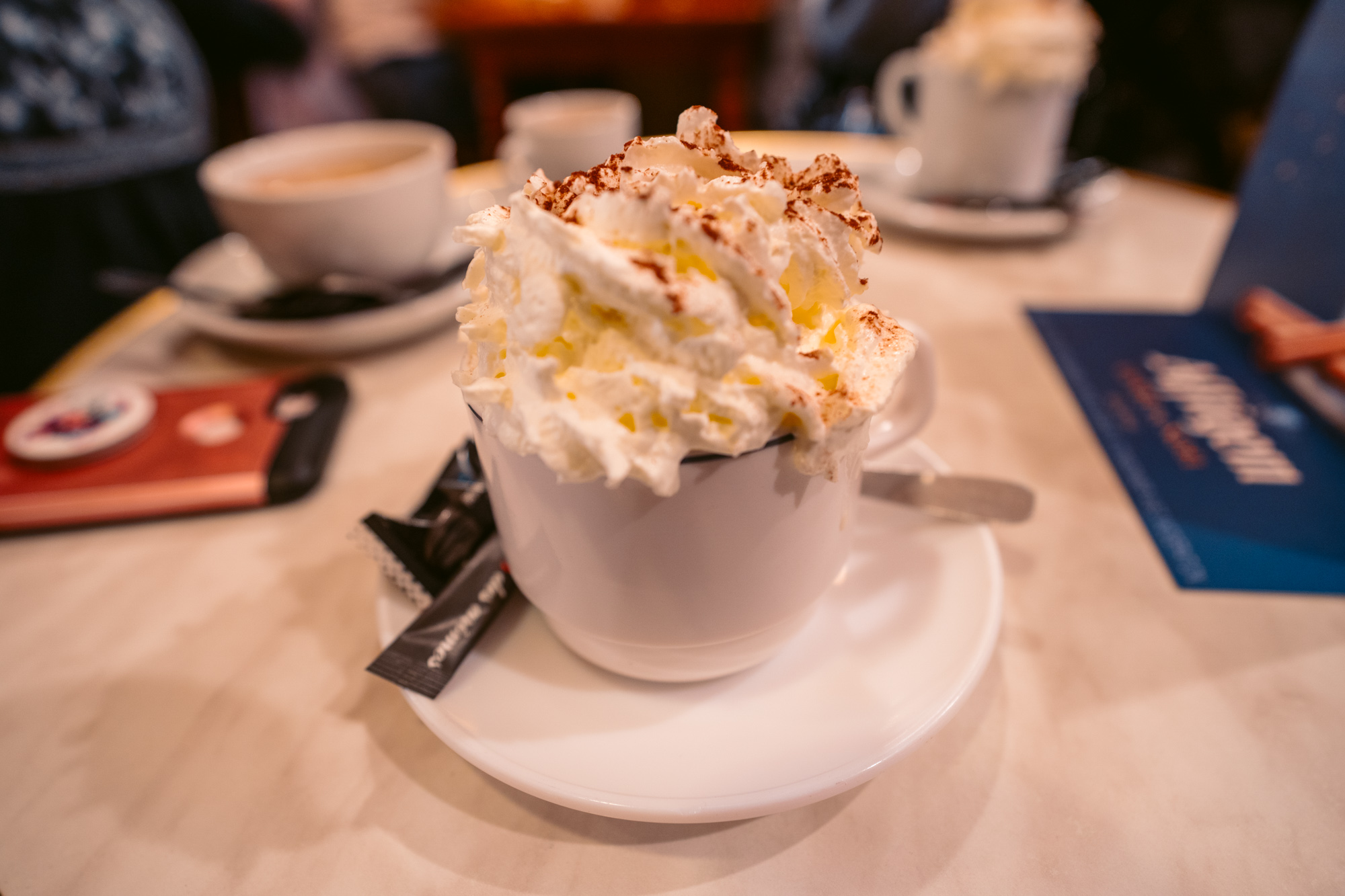
9. Bartholdi Museum
Alright, now might be a good time to tell you about a fella named Frédéric Auguste Bartholdi.
Even if you don’t know him by name, I guarantee you know his work. After all, this is the very genius behind the Statue of Liberty! There are quite a few Bartholdi sights in Colmar (they clearly love him), the most obvious being a museum dedicated to his life and work.
The (aptly named) Bartholdi Museum is located in the artists former house, where he was actually born! After Bartholdi’s death his widow bequeathed the house to the city of Colmar on the condition that it be turned into a museum about him. While it was delayed by WWI, the museum was opened in 1922.
Along with the beautiful 18th century building itself, visitors can see various models and sketches of the Statue of Liberty, along with a range of his other works, including sculptures, drawings, and personal items. The front courtyard which showcases the bronze sculpture Les Grands Soutiens du Monde is also a highlight.
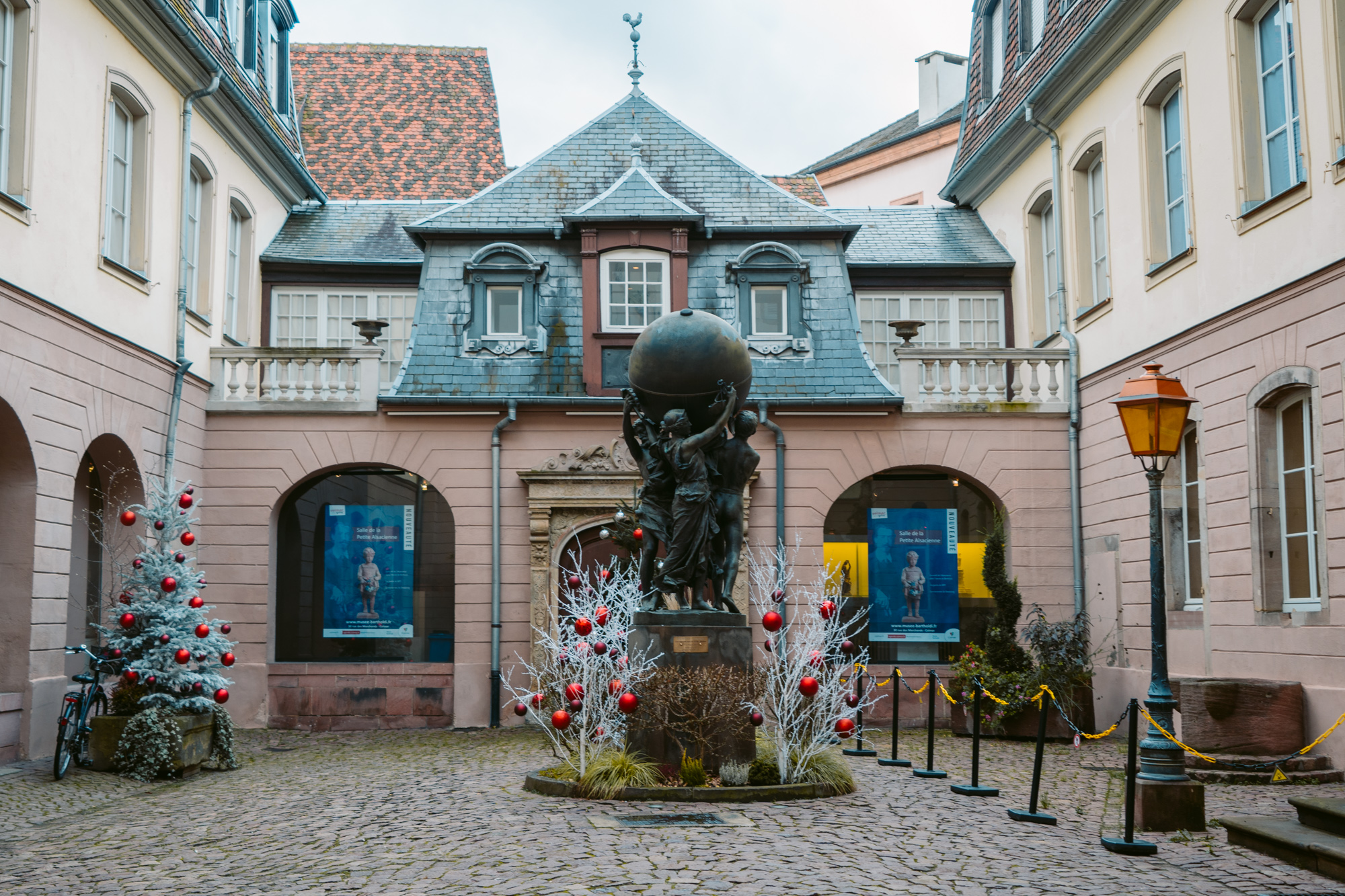
10. Bartholdi’s Statue of Liberty
A lesser-known landmark of Colmar’s is its own Statue of Liberty, a smaller-scale replica of the famous Statue of Liberty in New York, which was unveiled on the 100 year anniversary of the death of Auguste Bartholdi.
NOTE: This statue is located in a pretty random spot, on the middle of a roundabout on the Rte de Strasbourg heading north out of the city, so I wouldn’t necessarily go out of my way to see it unless you have a car and are driving past.

11. Unterlinden Museum
Another Colmar museum to visit for art enthusiasts is the Unterlinden Museum, home to an extraordinary collection of art and historical artifacts.
Housed in a former 13th-century Dominican convent, the museum opened in 1853 and has since become one of the most visited museums in France. The Unterlinden Museum’s significance lies in its vast and varied collections, which span from prehistoric times to contemporary art.
The museum is most famous for the Isenheim Altarpiece, a masterpiece of Renaissance art created by Matthias Grünewald and Nicolas of Haguenau, which draws visitors from around the world. It also houses an impressive array of paintings, sculptures, decorative arts, archaeological artifacts, antique weapons, and local folk art – so there’s basically something for everyone here!
It costs €13 for adults to visit, although there are concessions available, and the museum is open Wednesday to Monday from 9am until 6pm.
12. Or visit another small museum
And for those seeking additional indoor things to do in Colmar, there are some smaller museums to visit as well focused on niche topics. Again, I wouldn’t say that museums are a highlight of the Colmar experience, but if you’re looking for activities to fill your itinerary, here are some options:
- Alsace Wine Museum: for everything you need to know about Alsace wines including tastings, of course. Buy tickets here
- Alsace Chocolate Museum: a fascinating museum about the history of chocolate making with demonstrations and lots of tasting opportunities. Buy tickets here
- Toy and Model Museum (Musée du Jouet): an extensive collection of toys from various eras, promising delight for visitors of all ages.
13. Parc du Champ de Mars
For those in search of a more relaxing Colmar activity, why not take a leisurely stroll through Parc du Champ de Mars? This delightful green space is filled with walking paths, fountains, and (you guessed it) a statue of Bartholdi.
If you want to explore the greener side of Colmar, this is a great place for it.
14. Relax in Square de la Montagne Verte
Speaking of green, another nice spot for resting your feet and people watching is the Square de la Montagne Verte.
Located in front of the old hospital, with gorgeous buildings on every side and some unique looking bench/sculptures all around the edge of the lawn, this is a great spot to relax.
There are also a couple of nice art galleries to check out on the rue, and you’re right by the covered market if you need some food!
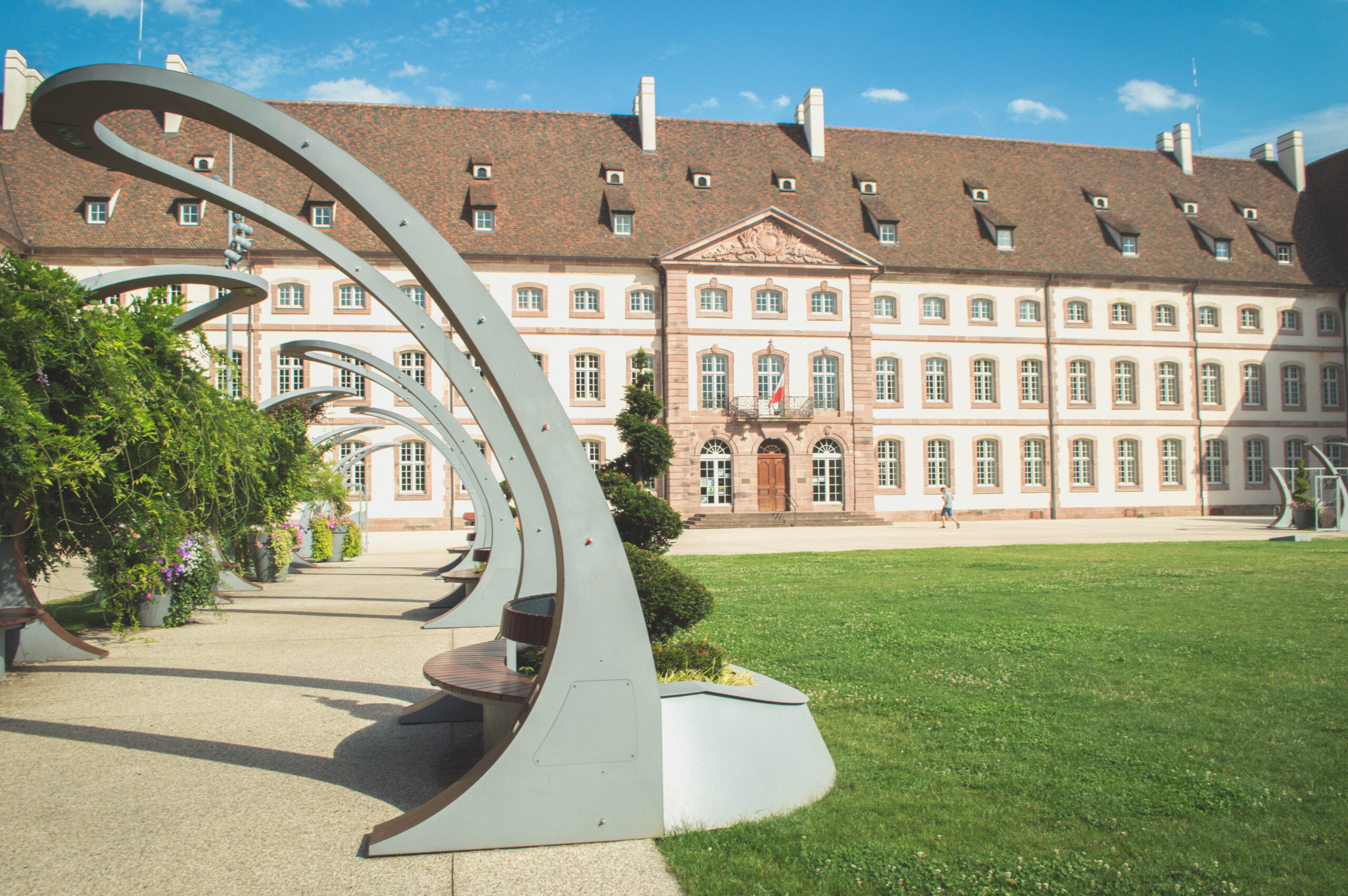
15. Visit Colmar’s Christmas Markets
Finally, if you’re still on the fence about when to visit Colmar, I can definitely vouch for the festive season, when the city’s already magical vibe is catapulted to new heights thanks to half a dozen Christmas markets, plus glitzy decorations all around town.
I’ll level with you: this is probably one of the busiest times to visit, but if you can come on a weekday earlier in the season, then it is 100% worth it. Just don’t expect to have the place to yourself!
You can check out my Colmar Christmas Market guide for more info.
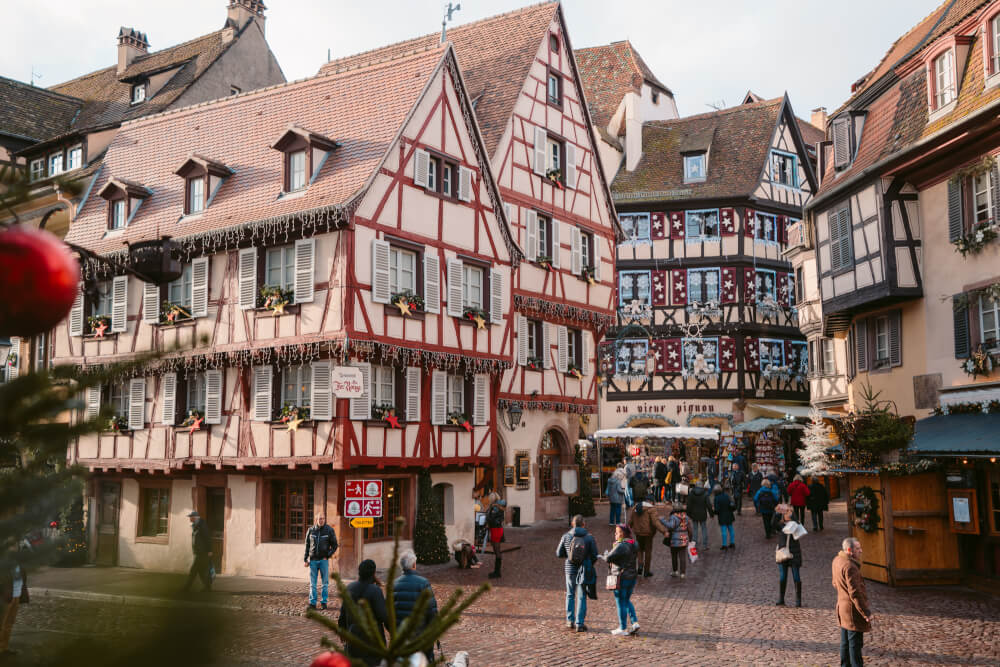
Did I miss any of your favourite things to do in Colmar?
Let me know in the comments so I can add more of the best Colmar activities to the list. Happy and safe travels! 🙂

